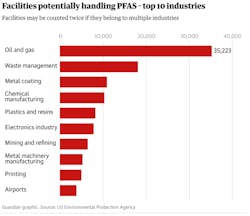To Best Remediate PFAS, Start at the Source
Across the U.S., thousands of per- and polyfluoroalkyl substances (PFAS) sources contaminate groundwater and threaten public water supplies. Fortunately, practical, highly effective, and sustainable remedies for treating these PFAS source zones are available and being deployed. Facility managers with a known PFAS source zone at their site should act now to reduce liability and exposure risk.
To Control PFAS Risk, Focus First on the Source
The EPA has identified more than 120,000 facilities that handle PFAS. Although PFAS are not formally regulated under the Clean Water Act, many utilities recognize the EPA's current Health Advisory Level (HEL) of 70 nanograms per liter (ng/L) combined for PFOA and PFOS or, commonly, more stringent state action levels. EPA has stated its intent to regulate PFAS and a draft for a maximum contaminant level (MCL) for these compounds could be due out in the Fall of 2022.
Left untreated, many of these PFAS source zones can form miles-long and maintain decades-lasting plumes of PFAS-tainted groundwater, potentially impacting clean water utilities downstream. When that happens, the utilities are left to treat the water to safe consumption levels, passing along the expense and significantly increasing costs to customers. Therefore, eliminating PFAS exposure risk starts with controlling the PFAS source. The American Water Works Association (AWWA) agrees:
The best way to keep drinking water safe is to protect it at its source. AWWA believes EPA should utilize existing laws to understand and control PFAS risks before harmful substances are introduced into commerce, and that PFAS producers–not consumers and water utilities–should be liable for cleaning up drinking water and the environment.
Using Colloidal Activated Carbon to Address PFAS Source Zones
The current best practice, and most effective approach, for treating PFAS source zones is to prevent PFAS migration away from them before the contaminants move further downstream in groundwater to impact water utilities, private wells, streams, or other sensitive receptors.
Oil & Gas and Waste Management Facilities Top EPA's PFAS Handling ListTopping the list of facilities that handle PFAS are more than 35,000 oil & gas production facilities known to have used fracking agents containing the chemicals. Other PFAS sources originate from a broad spectrum of industrial facilities such as landfills, metal coating and machinery manufacturing; chemical, plastics, and resins production; electronics; mining and refining; pulp and paper mills; printing facilities; and the PFAS manufacturers themselves. Some of the earliest identified PFAS sources were found at airports and military bases, where aqueous film-forming foams (AFFF) were used for firefighting emergencies and training exercises. These exercises were typically performed on an area of tarmac drained by municipal sewers or in burn pits dug into the ground. In recent years, contamination from these AFFF-PFAS source zones impacting downstream water utilities has been widely reported in the media. They are an early indicator of the scope of the problem as many more PFAS sources await to be identified. |
This sequestering of PFAS source zones is achieved by enhancing the soil's ability to sorb the contaminants. Currently deployed source zone treatments use a patented, liquid form of colloidal activated carbon (CAC). The CAC treatment is injected into the aquifer materials using specialty pumps, equipment, and tooling. Once applied, the CAC material coats the soil grains with a thin layer of carbon, removing PFAS from groundwater on contact as they migrate through the treatment zone and eliminating any risk to water resources.
By permanently enhancing the soil's sorptive capacity, PFAS become fixed at the source and cannot contribute to groundwater plume formation. Typical single-application CAC treatments effectively remove PFAS from groundwater and prevent downstream PFAS exposure risk for decades.
Preventative treatments using CAC and other engineered amendments can also be applied to PFAS-impacted soils above the groundwater (i.e., vadose soils). These vadose soil treatments prevent plume formation resulting from precipitation infiltration and PFAS leaching from the soil. Solidification agents may also be added to reduce soil permeability and contact with infiltrating water.
Crucially, these source zone treatment methods do not generate additional PFAS waste streams, allowing facility managers to effectively address these source zones without creating more exposure risk and liability.
Traditional Remedial Approaches Generate PFAS Waste Streams
Traditional remedial approaches used to manage organic contaminants include excavation and disposal (dig and haul) and groundwater extraction and treatment (pump and treat). Both approaches generate PFAS solid wastes, either by excavating contaminated soils from PFAS source zones or decades of pump and treat system operations that require massive quantities of spent carbon to be managed over time.
According to the EPA's December 2020 Interim Guidance on the Destruction and Disposal of Perfluoroalkyl and Polyfluoroalkyl Substances (PFAS) and Materials Containing PFAS, interim storage is listed as the "least uncertain" method for treating these PFAS wastes. EPA's suggestion to just hold onto the wastes, for now, speaks volumes to the unproven safety and effectiveness of the traditional landfilling and thermal treatment approaches for PFAS.
Uncertainties Regarding Landfill Disposal of PFAS Wastes
When landfilling PFAS waste, hazardous-waste-appropriate engineering controls (high-performance liners and leachate collection systems) are required to prevent the "forever chemicals" from leaking back into the environment. The level of engineering controls needed for this could be extreme.
For instance, recent testing for PFAS in New Hampshire reveals groundwater contamination above actionable levels at all six of the state's lined landfills. And of course, there is a cost to hazardous waste management, with current disposal fees at RCRA Part C Hazardous Waste facilities typically approaching or exceeding $400 per ton.
Uncertainties Regarding Thermal Incineration of PFAS Wastes
The other traditional method for treating hazardous wastes, thermal incineration, is fraught with uncertainties for PFAS, as expressed in the US EPA Guidance.
"There is a lack of PFAS-specific information available for these facilities," the guidance states. "U.S. EPA currently has no emission characterizations from these sources when they burn PFAS and is working to develop measurement methodologies as well as gather information to conclude whether potential products of incomplete combustion (PICs) are adequately controlled. U.S. EPA recognizes that PICs are formed (even for non-fluorinated compounds); however, based on the unique characteristics of fluorine combustion chemistry, it needs to be determined whether thermal treatment devices and their associated post-combustion control devices are controlling fluorinated PICs."
The uncertainties surrounding PFAS waste management are due to the extraordinary chemical persistence of PFAS. They do not naturally degrade like most other organic contaminants and readily accumulate in human, animal, and plant tissues. These factors result in exceedingly low parts-per-trillion concentration risk screening levels being applied ahead of U.S. EPA's assigning MCLs under the Clean Water Act. Clearly, remedies that address PFAS source zones without generating more PFAS waste streams are needed.
Combine Source Zone Treatments & Plume Monitoring to Reduce PFAS Liability
Demonstrating a groundwater plume's attenuation is often enough to convince regulatory authorities there is no exposure risk to downstream populations, assuming no receptors have already been impacted. This "stable or shrinking plume" condition is validated by an established groundwater remediation process called Monitored Natural Attenuation (MNA).
MNA is perhaps the most common remediation approach used for addressing groundwater contaminant plumes. It is often combined with source zone treatments to reduce the contaminant mass that charges these plumes. Industry researchers are now studying MNA's application to PFAS; and quick adoption is anticipated.
Due to their unique chemical nature, it will be impossible to demonstrate plume stability via MNA without addressing the PFAS sources in many instances. Starting at the source with practical, effective, and economical remedies to control the plumes — without generating more PFAS waste streams — offers the best solution.
References
1. Gillam C, Chang A. Revealed: more than 120,000 US sites feared to handle harmful PFAS ‘forever’ chemicals. The Guardian. https://www.theguardian.com/environment/2021/oct/17/us-epa-pfas-forever-chemicals-sites-data. Published October 17, 2021. Accessed January 24, 2022.
2. 15683PFAS_web.pdf. Accessed September 21, 2021. https://www.awwa.org/Portals/0/AWWA/ETS/Resources/15683PFAS_web.pdf?ver=2019-11-12-133836-883
3. Interim Guidance on the Destruction and Disposal of Perfluoroalkyl and Polyfluoroalkyl Substances and Materials Containing Perfluoroalkyl and Polyfluoroalkyl Substances. :107.
4. 4-28 Excavation, Retrieval, and Off-Site Disposal. Accessed January 24, 2022. https://frtr.gov/matrix2/section4/4-29.html
5. Newell CJ, Adamson DT, Kulkarni PR, et al. Monitored Natural Attenuation to Manage PFAS Impacts to Groundwater: Scientific Basis. Groundwater Monitoring & Remediation. 2021;41(4):76-89. doi:10.1111/gwmr.12486
6. Newell CJ, Adamson DT, Kulkarni PR, et al. Monitored natural attenuation to manage PFAS impacts to groundwater: Potential guidelines. Remediation Journal. 2021;31(4):7-17. doi:10.1002/rem.21697
About the Author
Ryan Moore
Ryan Moore, CHMM, is a REGENESIS PFAS program manager, focused on collaborating with environmental professionals and the industry to communicate effective, proven approaches to manage sites where PFAS contaminants exceed regulatory standards. Moore has managed the use of PlumeStop, Colloidal Activated Carbon, available exclusively through REGENESIS, to treat PFAS and other organic pollutants since its inception in 2014. Contact him at [email protected] or 219.286.4838.



